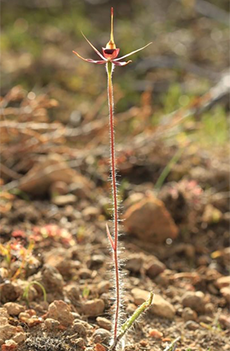<< BACK TO PROJECT LIST
Project: 345/2022
Title: Conserving and monitoring the Ovate Spider Orchid (Caladenia ovata) on Kangaroo Island
Applicant: Dr Richard Glatz
Institution: D’Estrees Entomology and Scientific Services, P.O. Box 16, Kingscote SA
We are small team looking at the rare Spider-orchid species, Caladenia ovata, or the Ovate-lipped Spider-orchid, on Kangaroo Island. This is a range-restricted species, with little known about its ecology or true population size.
Through our project we hope to get a better idea of the true population size of the species. We are using a quadrat-based methodology to examine multi-seasonal emergence, as well as identification of individuals at point of flowering. We are also using the cohort of plants within the quadrats to assess other variables such as herbivory, predation rates, natural pollination rates and successful seed set.
Another key aim of our project is to identify the unknown pollinator of this species.
We are using our Australian Orchid Foundation grant to establish our transect assets, institute the baseline work and assist with our pollinator baiting program. If we can successfully capture the unknown pollinator of C. ovata using the flower-baiting methodology, this may reveal information about the unusual flowering habitus of this species.
There is scope to expand the work in future years, following the large cohort of plants within the transects to the point of flowering, allowing for specific identification and an appreciation of year on year dormancy rates.



Project Outcomes:
My project was focused on the endangered Spider-orchid, Caladenia ovata, or the Ovate-lipped Spider-orchid. This species is only known with certainty as a wild species from Kangaroo Island, off the southern coast of South Australia. It has also been reported from a small population known from the adjacent Fleurieu Peninsular, however the status of this population is currently under review.
My project had three aims:
- to survey sites from which the orchid had been recorded in a historical context, but has not been found contemporaneously or where it’s presence might be suspected;
- to attempt to capture the unknown pollinator insect, which is presumably a Thynnid or other wasp;
- finally, to use a transect methodology developed by Reiter et al. (currently unpublished) to not only follow discreet populations of the orchid through, year on year, to confirm speculative species ID based on leaf observations via flowering in subsequent years, but also to attempt to quantify predation by grazing macropods and other influences, as there has been concern expressed about the high level of such impacts on these orchid and other rare plant population that occur in the general area.
A new observation was made of the orchid in a site where it was last seen over twenty years ago and, despite targeted searches, has not been noted since. All other areas that were searched outside of known populations produced no positive results.
The pollinator was unable to be located. Other contemporary baiting attempts, using various other species of wasp-pollinated Caladenia species across the same time window invariably produced results, but despite nearly 30 hours of baiting exposures over the two seasons of the project, no approaches of any insects to bait flowers presented and exposed in the conventional manner were noted.
A novel approach to locate the pollinator of this somewhat atypical Caladenia species may need to be adopted to finally reveal the pollinator insect, an important piece of the ecological jigsaw puzzle.
Finally, the transect-based aspects of the project proved successful, with far more detailed estimates of the total population of these orchids, and the extremely high rates of predation of this species being quantified via this methodology. While ideally this effort would be carried on over further years to strengthen the confidence around these findings, in particular those of verified plant population size, the effectiveness of the method employed was obvious.
The findings that were uncovered during this project have informed efforts currently underway to improve and strengthen the conservation rating of this rare species.


